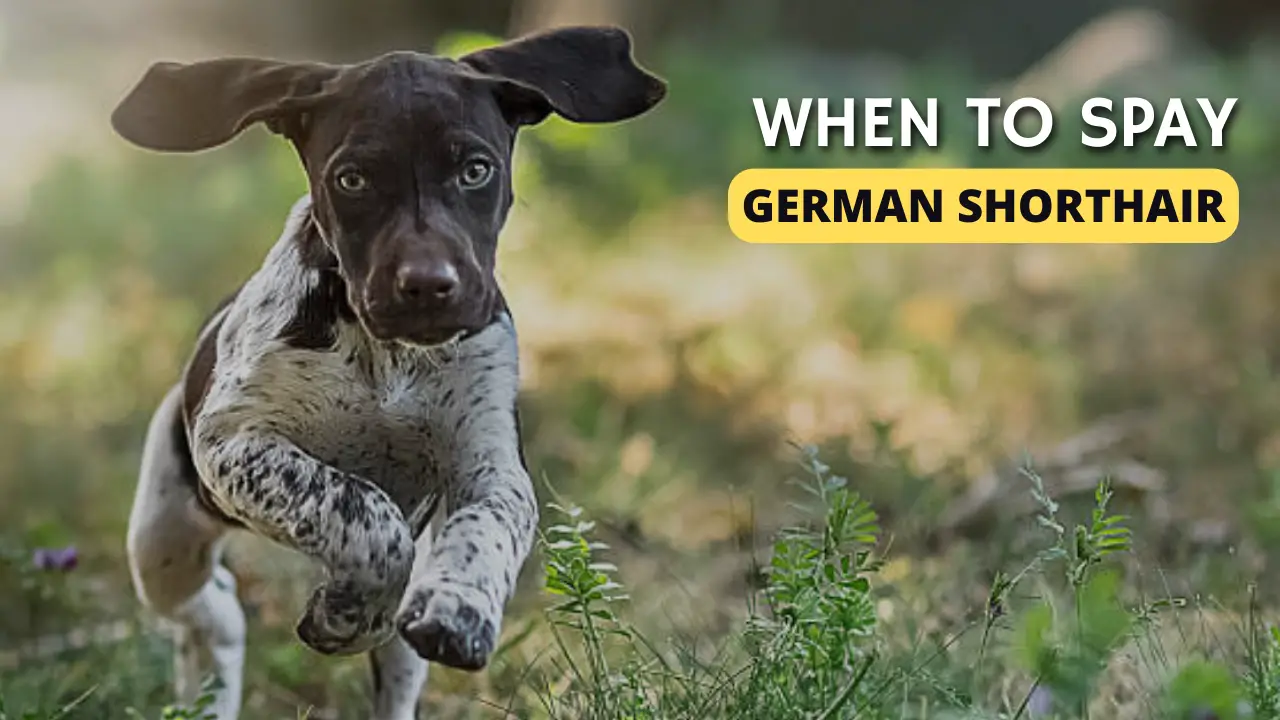German Shorthaired Pointers are gentle dogs perfect for families with young children. These dogs don’t display aggressive behaviors and require very little attention. However, despite how great this breed is, the last thing an owner on a tight budget wants is for their female dog to have more GSP puppies.
If you currently have a female GSP at home, spaying is a must if you don’t want it to reproduce. But it would help if you did it at the right age to be safe.
This guide will tell you when to spay your German Shorthaired Pointer and the advantages of this procedure for your pet if you decide to go ahead.
When To Spay Your German Shorthaired Pointer
The ideal time to spay your German Shorthaired Pointer is between the ages of four and nine months. This is the best age range because you should get the procedure done only after female dogs become adults and are mature enough to handle it.

Respected veterinarians recommend spaying your purebred dog before it reaches its first heat cycle. The idea is you significantly reduce the chances your dog will have health problems in the future because it will have a more robust immune system. Another reason why spaying your German Shorthaired Pointer early makes sense is that it makes the operation safer with less risk of bleeding out.
What’s The Difference Between Spaying and Neutering?
Whether you spay or neuter your dog, both procedures produce the same goal, which is to take out your pet’s reproductive organs so they can’t have any offspring. But there are some differences between spaying and neutering your German shorthaired Pointer you should know about.
Neutering Male German Shorthaired Pointers
Neutering is when you remove the male dog’s testes so it no longer has the capability or urges to reproduce. The procedure is irreversible, and your male dog cannot breed after it’s complete.
Most dogs will also not have the same urges for sex they had before the surgery, although some will. The entire process takes 5 to 10 minutes, and neutered dogs take less than a week to heal fully.
Spaying Female Dogs
Spaying is when the doctor removes the uterus and ovaries of a female dog. Throughout the surgery, your German Shorthaired Pointer will be under anesthesia so your pet will not feel any pain.
Your veterinarian begins by opening the abdominal cavity and cuts off the blood flow from specific areas of your German Shorthaired Pointers body. Like neutered dogs, your spayed pet needs sufficient time to heal. However, the most significant difference is the surgery is more complex.
You can expect female German Shorthaired Pointers to be like other dogs and take up to a month to heal correctly after the spaying surgery.
When Does Your Female Dog Begin Its Heat Cycle?
You can expect German Shorthaired Pointers to begin heat anywhere from 6 to 14 months, depending on when their mother started.
Once their initial heat cycle ends, the next one will start in another six months, and this cycle will continue for as long as your German Shorthaired Pointer is alive. If you don’t have a GSP, you will notice heat cycles start before six months if your dog is small, like a beagle.
After every six months, dogs experience heat cycles, and their growth hormones are at their highest. All cycles typically last anywhere from 16 to 18 days.
There are potential risks, so you must always look for signs that your German Shorthaired Pointer will start the heat cycle. Some symptoms you should look out for include the following:
- An inflated vulva
- Discharge with a brown and red hue
- They lick their behinds more than usual
- Need to pee more times per day
Also, your German Shorthaired Pointer will start to display the following habits:
- Tries to escape your home alone to meet other canines
- Humping
- They act restless and uncomfortable
- The tail is pointing in an awkward position
What Occurs If You Spay A Dog Early?
Whether you spay or neuter your dog, doing it early will harm its hormonal systems.
Once you have the surgery done and cut its reproductive organs, hormone levels decrease immediately. The result of this drop will mean serious health problems like breast cancer, heart disease, and elbow dysplasia as they age.

Below are some health conditions your dog will experience if you spay her early.
#1 Weight Gain
Spayed female canines will gain weight even if they eat the same calories they ate before the surgery.
Usually, your German Shorthaired Pointer will want to eat more, but her metabolism will not catch up with the food intake, causing severe weight issues. And the weight gain will lead to an increased risk of heart problems, joint disorders, and mast cell tumors that can become cancer.
All the above diseases will decrease your pet’s lifespan, and you will get less time with them.
#2 Hip Dysplasia
Hip dysplasia is a skeletal disease that weakens your dog’s bones as they age. Eventually, your dog will have problems with its hip joints when they stop growing normally.
The bones then start to misalign and rub against each other, causing severe pain. And once the joints are not strong, they can no longer function or remain useful.
Some common symptoms of this skeletal condition include soreness and weakness in the hind legs. In addition, the symptoms cause your German Shorthaired Pointer to walk unevenly, making it more difficult to stand from a sitting position. If you are sure your dog has this disease, keep it away from stairs, or a severe injury could occur.
#3 Behavioral Issues
Spaying your dog will sometimes change its personality and behavior at home. For example, it will become slightly paranoid and show fear when it hears random sounds.
It will also feel more anti-social when exposed to strangers and new environments. Additionally, loud popping noises coming from fireworks and garbage trucks will terrify your spayed German Shorthaired Pointer.
Lastly, some will express their anti-social behavior around strangers by acting aggressively and growling at them.
#4 Low Growth Hormone Levels
Growth hormones are depleted after being spayed, and this is terrible news. A lack of growth hormones weakens bones and will cause your dog to lose its hair.
Dogs who lose growth hormones will barely be able to run and be less active in your home. These symptoms will come and go. One solution to this problem is to have your dog injected with growth hormone shots, although it helps the problem temporarily only.
Summing It Up
Spaying your female German Shorthaired Pointer between the ages of four and nine months old is the best option. But if your dog has still not reached the age of maturity and has not had its first heat cycle, we recommend you wait until it does.
Spaying your dog before it’s ready can cause health care issues in the future, so always consult with your vet before you decide it’s time.
If you have a German Shorthaired Pointer in your home, females hit sexual maturity anywhere from 5 to fourteen months. The way to be sure is to be on the lookout for the signs like a gorged vulva and a brownish-red discharge that signifies the beginning of the heat cycle.
Putting your female dog through the spaying process has pros and cons. Some advantages mentioned above include tumor prevention, a calmer personality, and long-term health benefits. We recommend paying for it the moment your pet is ready.

